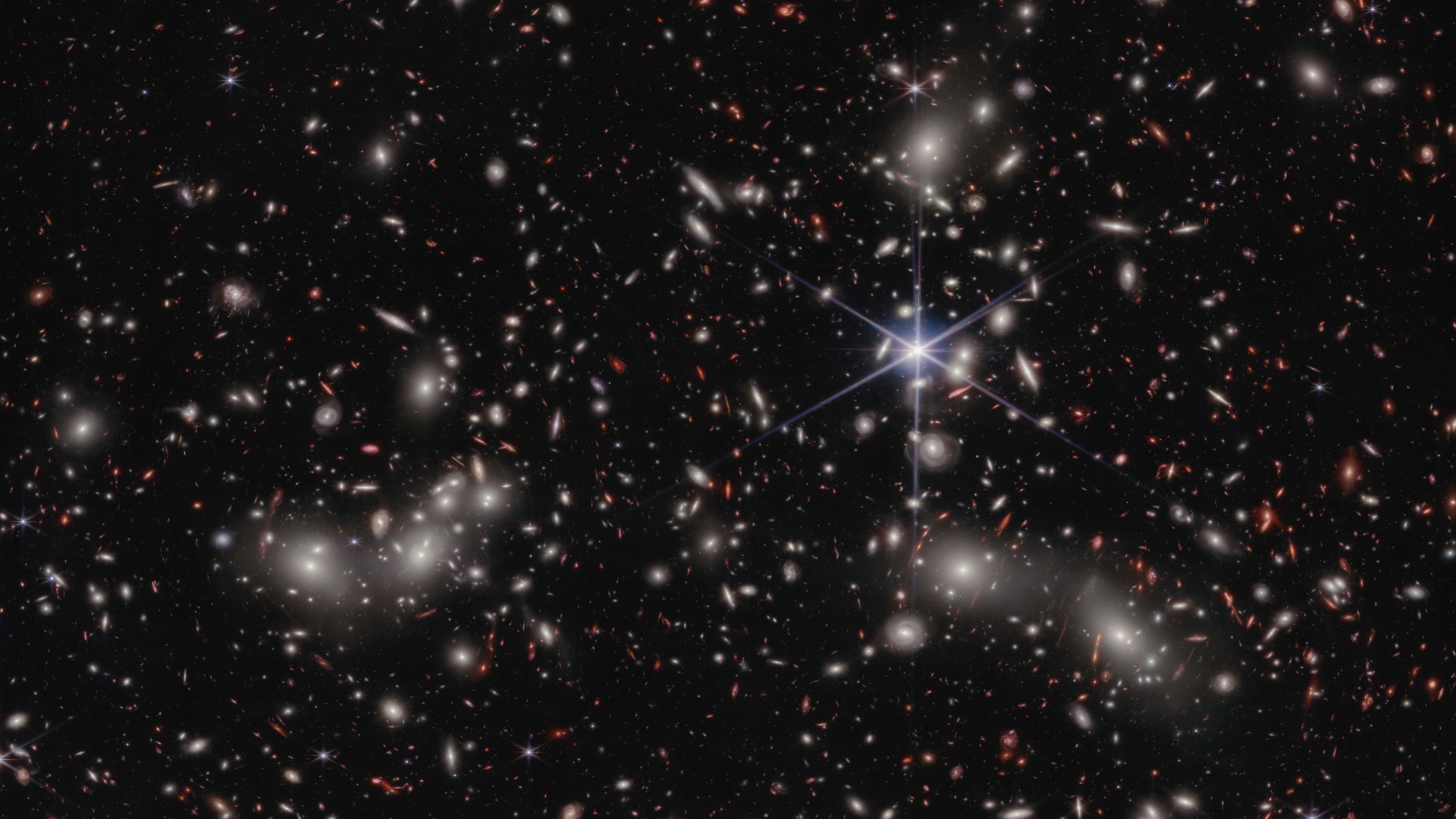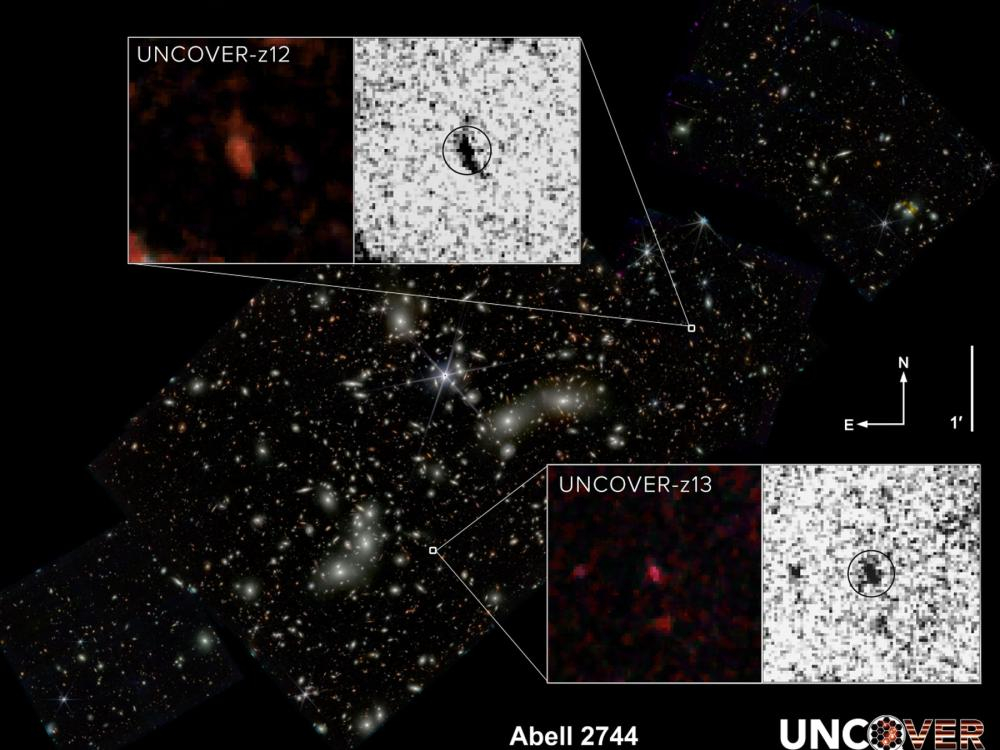James Webb Space Telescope finds 2 of the most distant galaxies ever seen
These two galaxies, magnified by a gravitational lens, have properties that support the basic picture of galaxy formation as described in the Big Bang theory.

The second and fourth most distant galaxies ever seen have been spotted by the eagle eye of the James Webb Space Telescope (JWST), supporting the basic picture of galaxy formation as described by the Big Bang theory.
The discovery was made possible thanks to a huge helping hand from a massive gravitational lens in the form of the galaxy cluster known as Abell 2744, nicknamed Pandora's Cluster, which is located about 3.5 billion light-years away from us. The immense gravity of the cluster warps the very fabric of space-time sufficiently to magnify the light of more faraway galaxies.
Using the James Webb Space Telescope to search for early galaxies magnified by this cosmic lens, Bingjie Wang of the Penn State Eberly College of Science and member of the JWST UNCOVER (Ultradeep NIRSpec and NIRCam Observations before the Epoch of Reionization) team discovered two of the highest redshift galaxies ever seen.
Related: James Webb Space Telescope confirms 'Maisie's galaxy' is one of the earliest ever seen
Cosmological redshift is the stretching of light wavelengths, provoked by the continuous expansion of the universe. The more distant a galaxy is, the more the universe had expanded while that galaxy’s light traveled across space to reach us, and therefore, the more the wavelengths of that light are stretched. As wavelengths get stretched out in this manner, they go from tighter, blueish ones to redder ones, eventually falling into the invisible, infrared region of the electromagnetic spectrum. Galaxies that existed just between 300 and 400 million years after the Big Bang have had their light stretched into those infrared wavelengths that can't be seen by humans, but can indeed be detected by the JWST’s Near-Infrared Camera (NIRCam) and Near-Infrared Spectrometer (NIRSPec).
Wang and her team were able to identify the lensed images of two high-redshift galaxies. One, designated UNCOVER-z13 ("z" is shorthand for "redshift"), has a redshift of 13.079, confirming it to be the second most distant galaxy known. (The most distant confirmed galaxy is JADES-GS-z13-0, which was also discovered by the JWST in 2022 and has a redshift of 13.2.) We see UNCOVER-z13 as it existed just 330 million years after the Big Bang.
The other galaxy recently discovered, UNCOVER-z12, has a redshift of 12.393, placing it in fourth place in the all-time list of most distant galaxies. We see this realm as it was just 350 million years after the Big Bang.
Get the Space.com Newsletter
Breaking space news, the latest updates on rocket launches, skywatching events and more!

What marks the two UNCOVER galaxies out as different is their appearance. Other galaxies seen at similarly high redshifts seem to be point-like, indicating they are very small — just a few hundreds of light years across. The UNCOVER galaxies, on the other hand, have structure.
"Previously discovered galaxies at these distances … appear as a dot in our images," Wang said in a statement. "But one of ours appears elongated, almost like a peanut, and the other looks like a fluffy ball."
These galaxies are also bigger, with UNCOVER-z12 sporting an edge-on disk about 2,000 light years across, which is six times larger than other galaxies seen in this era.
"It is unclear if the difference in size is due to how the stars formed or what happened to them after they formed, but the diversity in the galaxy properties is really interesting," said Wang. "These early galaxies are expected to have formed out of similar materials, but already they are showing signs of being very different than one another."
Although the dichotomy in galaxy properties, even at this early stage in the universe, is eye-opening, both of the newfound realms have general characteristics that are strongly supportive of the Big Bang model. This model describes how, in the aftermath of our universe's creation, galaxies began life small before growing rapidly through mergers with other galaxies and gas clouds.
This growth, in turn, spurred more star formation, which ultimately increased the abundance and variety of elements contained within the young galaxies, introducing substances to them that are heavier than hydrogen and helium. The galaxies uncovered by UNCOVER — if you’ll pardon the pun — are young, small, have a low abundance of heavy elements and are actively forming stars, all of which supports "the whole paradigm of the Big Bang theory," Joel Leja, who is an assistant professor of astronomy and astrophysics at Penn State University and a co-researcher on Wang’s team, said in the statement.
Interestingly, the JWST has the ability to see even higher redshift galaxies than UNCOVER-z13 and -z12, meaning they'd be even younger — but it didn’t detect any being lensed by the Pandora Cluster. "That could mean that galaxies just didn’t form before that time and that we’re not going to find anything farther away," said Leja. "Or it could mean we didn’t get lucky enough with our small window."
Astronomers will keep looking, using a multitude of lensing clusters to open up new windows into the deep universe in search of some of the first galaxies.
The discovery was reported on Monday (Nov. 13) in Astrophysical Journal Letters.
Join our Space Forums to keep talking space on the latest missions, night sky and more! And if you have a news tip, correction or comment, let us know at: community@space.com.

Keith Cooper is a freelance science journalist and editor in the United Kingdom, and has a degree in physics and astrophysics from the University of Manchester. He's the author of "The Contact Paradox: Challenging Our Assumptions in the Search for Extraterrestrial Intelligence" (Bloomsbury Sigma, 2020) and has written articles on astronomy, space, physics and astrobiology for a multitude of magazines and websites.
-
rod Space.com reported, "These two galaxies, magnified by a gravitational lens, have properties that support the basic picture of galaxy formation as described in the Big Bang theory...Wang and her team were able to identify the lensed images of two high-redshift galaxies. One, designated UNCOVER-z13 ("z" is shorthand for "redshift"), has a redshift of 13.079, confirming it to be the second most distant galaxy known...The other galaxy recently discovered, UNCOVER-z12, has a redshift of 12.393, placing it in fourth place in the all-time list of most distant galaxies. We see this realm as it was just 350 million years after the Big Bang...What marks the two UNCOVER galaxies out as different is their appearance. Other galaxies seen at similarly high redshifts seem to be point-like, indicating they are very small — just a few hundreds of light years across. The UNCOVER galaxies, on the other hand, have structure. "Previously discovered galaxies at these distances … appear as a dot in our images," Wang said in a statement. "But one of ours appears elongated, almost like a peanut, and the other looks like a fluffy ball." These galaxies are also bigger, with UNCOVER-z12 sporting an edge-on disk about 2,000 light years across, which is six times larger than other galaxies seen in this era…Although the dichotomy in galaxy properties, even at this early stage in the universe, is eye-opening, both of the newfound realms have general characteristics that are strongly supportive of the Big Bang model…"Reply
My observation, cosmology calculators (example, https://lambda.gsfc.nasa.gov/toolbox/calculators.html, and https://www.kempner.net/cosmic.php) show the angular size distance. It does appear that problems exist for the BB cosmology concerning high redshift galaxy sizes and the one arcsecond map size to redshift number as well as comoving radial distances where space expands much faster than c velocity today. At the comoving radial distances, the large red shift galaxies cannot be observed and measured, thus any cosmic evolution using those distances is not verifiable. JWST does not see the pristine, primordial gas clouds said to exist in the early universe created during BBN, only metal poor but no metal free gas clouds and no Population III stars confirmed. -
rod This report reflects some of what I mentioned in post #2 concerning different distances used in BB cosmology model to explain the expanding universe.Reply
https://phys.org/news/2023-11-second-most-distant-galaxy-james-webb.html
"Because the light from these galaxies had to travel for so long to reach Earth, it provides a window into the past. The research team estimates that the light detected by JWST was emitted by the two galaxies when the universe was about 330 million years old and traveled for about 13.4 billion light years to reach the JWST. But, the researchers said, the galaxies are currently closer to 33 billion light years away from Earth due to the expansion of the universe over this time."
The 33 billion light years distance opens the door to space expanding more than 2x c velocity and cosmic evolution taking place that is not visible or observable today from Earth. Small items like this in BB cosmology I feel should be clearly documented to the public, IMO.









